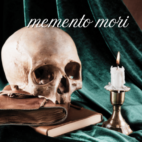Memento Mori
Talking about death has been deemed morbid, taboo, or even pathological. But in order to fully embrace life, scientists, psychologists, and spiritual leaders all agree—that contemplating death is the key to living a life with meaning.
This blog serves as a resource for those captivated by the history, art, and symbolism of cemeteries and other places of death.
Historically, memento mori were prevalent in ancient civilizations. In Egypt, dried skeletons were paraded during feasts to highlight life’s transience. In Rome, dining areas often featured skeleton mosaics, and guests might receive tiny bronze skeletons, known as larva convivialis or “banquet ghosts,” as reminders to seize the day.
Examining death through cemetery research offers a profound way to practice memento mori, as it bridges the historical, cultural, and personal dimensions of mortality. Cemeteries serve as physical reminders of life’s transience, with headstones, epitaphs, and funerary art embodying the legacy of those who came before us.
By studying burial practices, inscriptions, and symbolic motifs; researchers can uncover societal attitudes toward death, grief, and remembrance across time.
Engaging with these spaces invites a contemplative reflection on our mortality and the impermanence of human endeavors, echoing the essence of memento mori. Furthermore, cemetery research fosters a connection to heritage, prompting individuals to consider how their lives will be remembered and what values they wish to pass on. This practice not only honors the dead but also enriches the living, encouraging a more intentional and mindful approach to life.

